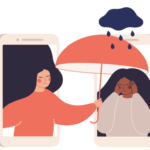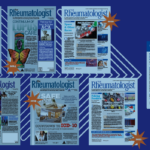You sit down at your partner’s desk at the end of a long day seeing patients in the office. You say aloud, “Things were going great until that last patient. She really took me out. She was mad at me for saying that the low-titer ANA [antinuclear antibodies] was not an issue and that she had only fibromyalgia. Go figure.”
How often have you spoken those words? Was this a difficult patient, or were you the cause of the problem? What is a difficult interaction for you, and what is the best way to deal with it?
The Problem
In the medical literature, the adjective “difficult” seems to be used often as a descriptor for a patient. Thus, we find synonyms for the difficult patient such as problem patients, angry patients, or even hateful patients. A search of the medical literature reveals nothing specifically written on this topic for rheumatology. In primary-care practices, the rate of encounters with difficult patients has been estimated to be between 15% and 30%.1 Not all of these patients have psychiatric problems, as you might initially think.
In his classic article, Grove describes hateful patients as one of the following: 1) clingers, 2) fearful patients, 3) help rejecters, or 4) self-destructive patients.2 Certainly, patients with these personality types can create a difficult interaction. I feel that although this was an early, valiant effort to address the issue, the language was too strong. Often these visits are uncomfortable rather than hateful. Difficult interactions may also center on drug problems, alcohol issues, or language barriers. Other times, the doctor’s own feeling or personality may be the issue. Did you notice the use of the phrase “only fibromyalgia” in the example above? Was the patient responding to your own unintended slight?
Perhaps we can best describe the source of the difficult encounter to be the patient, physician, other provider, or the illness, with the result being that either party feels the interview was unsuccessful. Whatever the frequency of such visits, it is clear that difficult patient interactions are common and can lead to significant dissatisfaction for both provider and patient, poor outcomes, low compliance, and even lawsuits.3,4
Tips for Better Encounters with a Difficult Patient
- What’s your trigger?
- Recognize a difficult encounter early.
- Discover the meaning of why the encounter is difficult.
- Enlist the patient to help you find a solution.
- Show empathy in your body language and words.
What Causes a Difficult Encounter?
The Institute for Healthcare Communication has been promoting workshops on the difficult patient for over a decade. The core teaching is that each provider should discover what constitutes a difficult patient for himself or herself. You may find yourself feeling upset by angry, manipulative, or somatasizing patients. Have you perhaps been sued by a patient similar to the one you are struggling with now? There may be a deep-rooted personal experience from your past. Your own prior experience can be at the core of the difficulty. Knowing your triggers will help you with the early recognition.
Providers are often troubled by the patient’s agenda. Up to one-third of patients visit the doctor for a reason other than their chief complaint. This brings up an “Oh, by the way” comment that addresses a patient’s real reason for visiting. White described that 21% of patients raise new problems at the end of the visit.5 A delayed broaching of a worrisome symptom may derail the entire interaction and annoy the clinician. What might engender such a delay? Patients may be deciding whether they can trust you. They might be embarrassed about, or fearful of, the implication of their symptoms (e.g., ischemic chest pain). Finally, they might be confused about the importance of a symptom.
At the University of Colorado Denver (UCD) School of Medicine, we teach the concept of the two CCs: the chief complaint and the chief concern. Providers need to understand what each of these is and remember that sometimes they are quite different. A patient may be worried about an issue or complication that you would never suspect.
Many providers find themselves troubled by powerful patient emotions. We deal with three prominent emotions in medicine: fear, sadness, and anger. We may be tempted to ignore or downplay these to save time and stress on our part. Anger may be most difficult to work with, but anger often stems from fear or sadness, easier emotions to empathize with. All of these emotions can dominate the conversation and consume time, and may often seem tangential to the primary illness.
We clinicians have a need to do our work well. Above all, we need enough time. In your clinic, you may be running behind and feeling stressed and as if you do not have enough time to deal with a high-affect patient. Your view of your role as a provider may also be an issue. You may not have difficulty with giving short-term narcotics for an acute pain situation, but you might feel less comfortable prescribing a high-dose narcotic for a long period of time for a patient who complains of chronic and severe pain. Or, you may think that filling out disability papers is the opposite of what your job is as a rheumatologist. In this situation, it may be that the interaction suffers from your lack of flexibility rather than something specific that the patient requests.
The Cure for Difficult Patient Interactions
The first step in dealing with difficult patient interactions requires us to recognize when a problem is occurring. One might be forewarned by the medical assistant or the receptionist who tells you “The next patient is a doozie.” Sometimes one has a physiologic response, when you see the patient and remember the last troubled visit. Perhaps, you may find yourself in the middle of an interview and realize you have repeated yourself three times. I believe that if you do not recognize that you are in a difficult interview early enough, you will lose any chance of rescuing the situation. To get out of trouble, you need to first recognize you are in trouble.
Stephen Covey wrote the successful book The 7 Habits of Highly Effective People.6 Habit five of the seven habits is “Seek first to understand, then to be understood.” This core skill urges discovery of the meaning of why there is a relationship problem. We might begin by asking the patient what they think the problem is or what are they really worried about. When speaking with an upset patient, you need to understand the meaning and genesis of their feelings.
This article begins with a woman with a positive ANA test. Why did she become upset when you told her that she did not have lupus, a disease none of us would want? Perhaps she had a loved one who had suffered or died from lupus, and that was her chief concern. Delving into that history might help the physician understand why she is upset at what should seemingly be good news. Perhaps she wanted more of an explanation as to why she was having pain. Or, finally, did she pick up on your own ambivalence about caring for “only fibromyalgia”? Is that phrase somehow demeaning and dismissive triggering an emotional response?
It can be our own issues that are undermining the visit. Whenever a visit goes sour, one must search for the reason, whether it’s one’s own issue or the patient’s concern. This skill is core to avoiding or turning around a problem visit.
The final step in curing an encounter lies in building empathy. Good interviewing skills are the key here. Open questions help discover the true meaning of patient communication. Empathy is an emotion, perhaps best projected by good nonverbal skills. Body language and tone of voice gives the majority of meaning to your words in emotional situations. If this is accompanied by words that suggest empathy, one has a chance of turning a sour visit around. The verbal component consists mostly of efforts to understand the patient fully and to let the patient know what we have understood. Often we can use a reflection statement that summarizes the issues you heard. In the vignette described in this article, you might have delved into what the patient was really concerned about and then tried to address it with caring and concern.
Empathy is indeed the bridge that helps make the clinician–patient connection and helps avoid or even cure the difficult interaction. If difficult patient interactions are a puzzle to be solved, empathy is often the most practical solution.
Dr. Boyle is associate professor of medicine at Denver Health Medical Center/University of Colorado Denver Health Sciences Center.
References
- Crutcher JE, Bass MJ. The difficult patient and the troubled clinician. J Fam Prac. 1981;11:933-938.
- Grove JE. Taking care of the hateful patient. N Eng J Med. 1978;298:883-887.
- Studdert DM, Mello MM, Brennan TA. Medical malpractice. N Engl J Med. 2004;350:283-292.
- Boyle D. What gets a good Rheumatologist sued? The Rheumatologist. 2007;1(11):1,16,21.
- White J, Levinson W, Roter D. “Oh, by the way …”: The closing moments of the medical visit. J Gen Intern Med. 1994;9:24-28.
- Covey S. The 7 Habits of Highly Effective People. New York, NY: Simon & Schuster; 2004.



